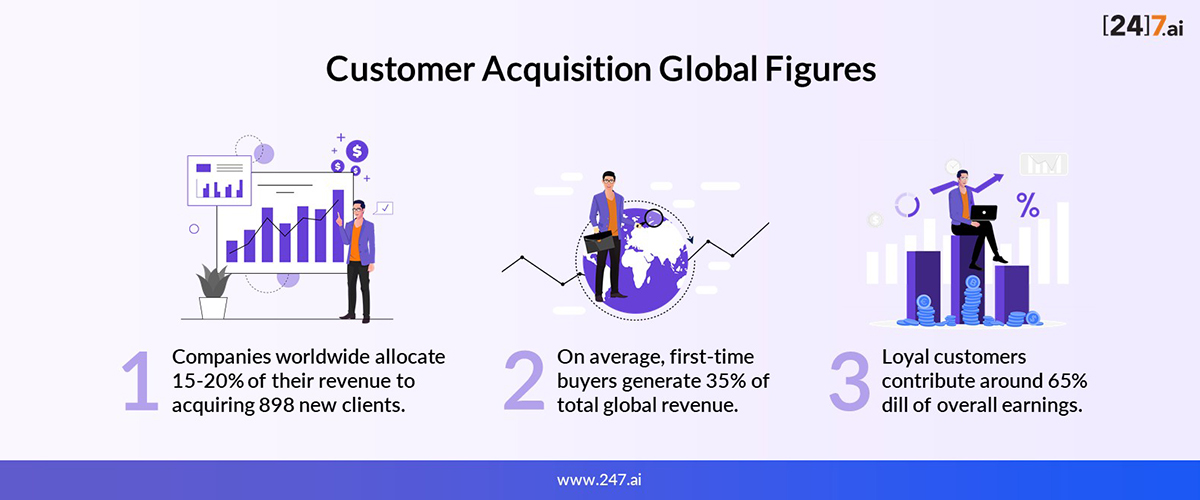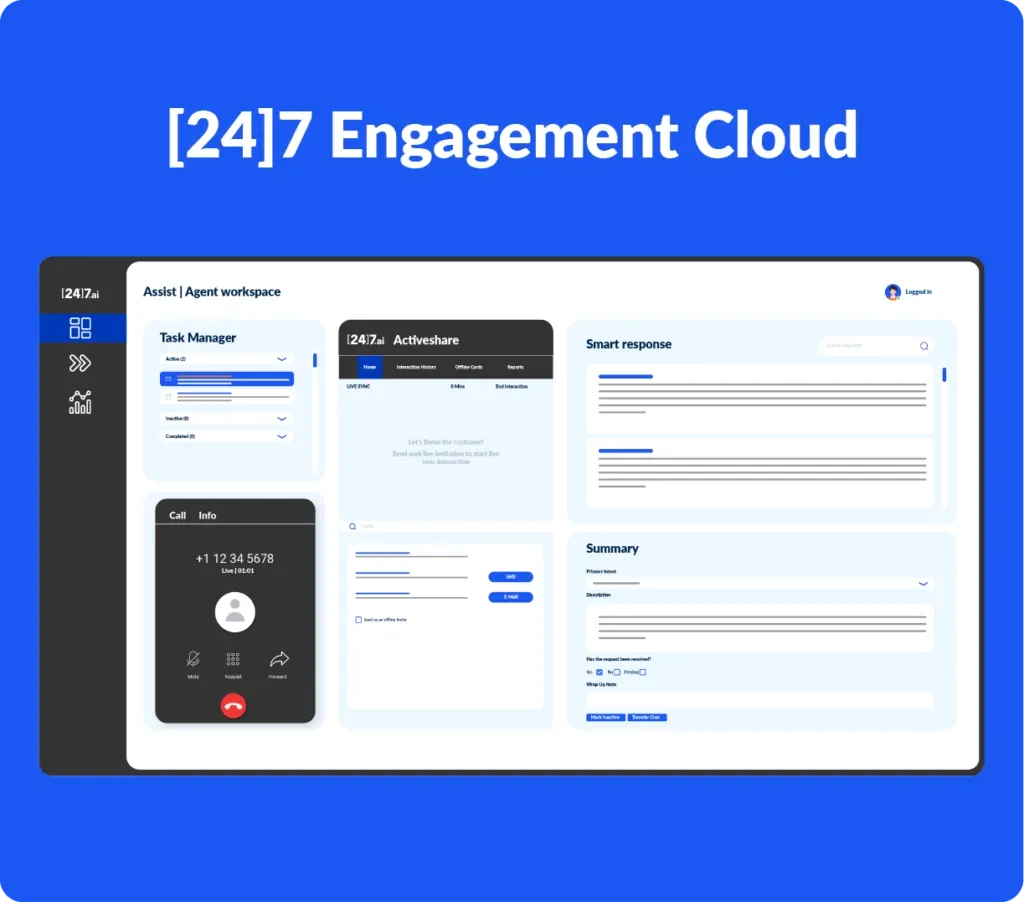Data says, new customers contribute to 35% of a firm’s revenue. This clearly shows that bringing in new customers is still a key way businesses grow, no matter the industry.
In order to achieve this, businesses of all sizes are coming up with creative ways to attract new customers and grow their customer base.
Customer acquisition refers to all actions taken by a business to find, reach out to, and turn potential customers into paying ones. With the market in constant flux and an increasing inrush of competitive forces, organizations need a complete customer acquisition strategy to grow sustainably and become market leaders. In this blog post, we will outline the key aspects of customer acquisition and 5 steps to help grow your customer base systematically.
Also, using customer analytics can add depth to your understanding. Companies leveraging customer analytics are far more likely to be successful in converting customers.
What is Customer Acquisition?

Customer acquisition begins the moment a prospective buyer comes in contact with your company for any services or products, for an immediate need or to gather first level information. Following this initial contact, this process goes through several steps such as generating interest, making a formal purchase decision, and eventually converting the prospect into a loyal and satisfied long-term customer.
Usually visualized as a funnel, the process starts at the awareness stage with a large audience, and narrows down to interest, consideration, intent, and then to purchasing. The fundamental philosophy of customer acquisition is to create a known and sustainable pipeline of new customers, and also that the new customers help create sustainable growth for the business in the long term.
Why is Customer Acquisition Important?

A business thrives and grows because of its customers, thus it goes without saying that gaining new customers are crucial to generating revenue and business expansion. Here are some specific points to elaborate on.
- Revenue Growth: New customers will contribute to and add to the organization's sales and profits.
- Market Expansion: Newer customer onboarding enables access to newer markets.
- Business Sustainability: A steady influx of new customer acquisition keeps the organization growing steadily and keeps the business stable.

5 Steps to Acquire More Customers
1. Identify the Target Audience

Data indicates that organizations with a strong ICP (Ideal Customer Profile) are able to achieve 68% higher win rates when compared to companies that don’t. The first step in any customer acquisition strategy is to identify your ideal customers. Consider the following factors while determining the right target audience:
- Demographics: Age, gender, income level, education level etc.
- Psychographics: Interests, values, lifestyle choices etc.
- Behavioral Data: Purchase history, brand interactions etc.
Also, using customer analytics can add depth to your understanding. Companies leveraging customer analytics are far more likely to be successful in converting customers.
2. Choose the Right Acquisition Channels
You should be there, where your customer is! Thus, it is important to choose the channels based on enough research and data. Here are some acquisition channels that will help you connect with the right target audience.
- Social Media: Social networking platforms such as LinkedIn, Twitter, Facebook, Instagram and similar platforms are the easiest way to reach, connect, and engage with potential customers - as appropriate to the industry. Focus on targeted marketing and interactive content to attract your prospects towards your brand.
- Content Marketing: Another effective way to reach your audience is to create content around their intent. Content focusing on what they are looking for to learn from, to get answers for, or to make a decision. Content types can be defined as per the target audience and the industry you belong to. White papers, videos, infographics etcetera can help you get their attention, to raise awareness, engage your audience, and build yourself as a brand that they are willing to reach out to when they have a need.
- Search Engine Optimization (SEO): It is important your website and content are visible in search results. It helps when your potential customers are searching for a specific requirement and they find you as a right fit. Research suggests that 91.5% of users stay on the first page of their google search, so it is important to optimize your website and content.
- Email Marketing: With email marketing being a channel, with the highest RoI where each dollar spent gets an average return of 36 dollars, this traditional approach is still preferred. A focused, personalized, and concise message works better rather than a direct approach that can be a bit overwhelming.
- Hyper-Personalized Ad Targeting and Optimization: Use advanced data analytics and machine learning to deliver highly customized advertisements based on individual user behavior, demographics, and purchase intent. This can be executed through Google Ads with custom audiences, Facebook/Meta's detailed targeting options, LinkedIn's professional targeting, programmatic advertising platforms, and dynamic retargeting campaigns. Continuous A/B testing and real-time optimization ensure maximum performance. By analyzing user data and optimizing ad experiences, businesses can significantly improve conversion rates and maximize advertising spend efficiency across digital touchpoints.
3. Craft Compelling Value Propositions
Highlight your product’s unique selling points with a compelling value proposition tailored to your buyer’s needs. Align it to the customer requirement you are catering too with a messaging that gives your customers a compelling reason to choose you.
4. Optimize the Customer Journey
Ensure a seamless experience from the first point of contact to the final point of purchase:
- Website Optimization: Customers on mobile and desktop devices should find your website easily accessible, well-structured and navigable to meet their requirements without friction.
- User Experience (UX): Design the website with intuitive navigation. Remove steps that are unnecessary and can hinder progress.
- Call-to-Action (CTA): Make clear, action-oriented ‘call to action’ that spur users to progress to the next point in their customer journey.
5. Analyze and Refine your Strategy
Evaluate your consumer acquisition strategy in regular intervals. This will help you determine your approach and understand the strategy to meet your business objectives.
- Track Performance: To determine the effectiveness of your customer acquisition, track the key metrics such as customer acquisition expenses, lead conversion rates, and client lifetime value etc.
- Test and Learn: It helps if you keep trying new methods to reach your prospects, try different messages, messaging channels, and campaigns to see what works with your audience.
- Listen and Adapt: Identify pain points, preferences, and opportunities to improve your strategy. Always remember this is an ongoing process and needs constant refinement.
By regularly assessing, monitoring, and modifying your customer acquisition plan, you will create a targeted and responsive acquisition strategy.
Deliver the Right Message to the Right Audience at the Right Time with [24]7.ai
Hyper-personalized ads are transforming how brands connect with customers by making every interaction feel personal, timely, and relevant. With AI-powered platforms such as [24]7 Target, businesses can deliver customized messages across channels such as websites, social media, and video, in real time. These ads aren’t static; they adjust dynamically based on customer behavior, preferences, demographics, and even past visits. Whether someone is just browsing or close to making a purchase, the ad experience adapts to meet them where they are.
This level of precision doesn’t just feel more human but it also drives real results. Brands using [24]7 Target have seen up to 2x higher click-through rates, 3x return on ad spend (ROAS), and 27% lower cost per acquisition. By analyzing user journeys and predicting intent, the systems create meaningful connections that guide customers from interest to action. It’s not about shouting louder, it’s about speaking smarter, to the right target, at the right time.
For organizations that are looking to elevate their new customer acquisition strategy, adopting a technology-enabled partner such as [24]7.ai can be the best fit. It not only supports the organizations with ability to engage with prospective customers, it also drives new customer acquisitions, and provides personalized experiences at scale, while increasing sales and maximizing return on ad spend.
Ready to Boost your Customer Acquisition Process?
Learn how [24]7.ai can help you acquire and retain more customers from its advanced AI-driven solutions. Visit [24]7.ai and see how to get started today.
Frequently Asked Questions
The most common customer acquisition challenges include adapting to customer needs, high costs, and choosing the right tools.
It's measured using metrics such as Customer Lifetime Value and conversion rates.
CRM and marketing automation tools help manage and streamline the process.
Acquisition brings in new customers; retention focuses on keeping existing ones.
It boosts engagement and increases the chance of conversion.



